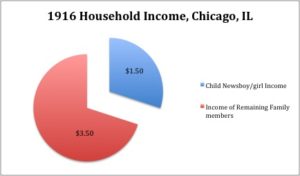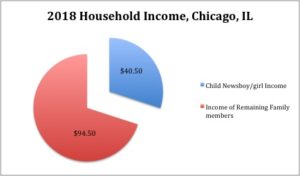Hull-House Maps and Papers was the culmination of two years of research accomplished by the residents of Hull-House, most notably Florence Kelley and Jane Addams. The project was centered within the diverse immigrant neighborhood around Addams’ settlement home on 800 South Halsted Street, Chicago, IL. The demographics of this neighborhood included Irish, German, Russian, Turkish, Polish, Italian, Swiss, French, French Canadian, Bohemian, Scandinavian, Chinese, and Arabian.
The Hull-House Maps and Papers was conducted door to door under the direction of Florence Kelley, who served as the Chicago Special Agent Expert for the United States Department of Labor. Two maps were plotted based on the findings of the research, which recorded people’s age, wage, number of weeks unemployed, nationality, position in household, profession, literacy, English proficiency, and native language. The maps showcased in the book include one based on nationality and the other based on wage. The wage maps are featured within this website to offer an important reference when considering the wages earned by children.
“…in this neighborhood, generally a wife and children are sources of income as well as avenues of expense; and the women wash, do “home finishing” on ready-made clothing, or pick and sell rags; the boys run errands and “shine”; the girls work in factories, get places as cash-girls, or sell papers on the streets; and the very babies sew buttons on kneepants and shirt-waists…” Hull-House Maps and Papers page 61.
The wage map was colored based on different brackets of weekly earnings in a “family.” This ranged from $5 and less to over $20. According to the map, the largest portion of this population earned between $5 to $10 a week. It was very hard to earn much, even with every member of the household working.
Keeping this in mind we might then consider what an average newsboy or girl earned when selling a stack of 100 newspapers on the streets of Chicago. In order to sell these newspapers, these children first had to spend their own money in hopes of making a profit or at least breaking even on their expense. In January of 1917, the Chicago newspaper, Abenpost, was reported on having set their selling price of newspapers for newsboys to 50 cents per 100 newspapers. After buying these newspapers, newsboys and girls would then turn around and sell their copies for either 1 cent or more. If these young vendors were able to sell all their newspapers, having sold them at the price for, lets say, 2 cents, than they would have earned $2.00. For households on the Hull House Maps, that $1.50 (Minus 50 cents because that would be saved for the next weeks expense in newspapers) would provide 30% of the weekly income for a family income that was listed in the $5 or less bracket. Going one step further, in relating it back to the present, $1 in 1916 equates to roughly $27 today; this means that for a 1916 family in the $5/week bracket, they would be only living off approximately $135 per week in 2018.

